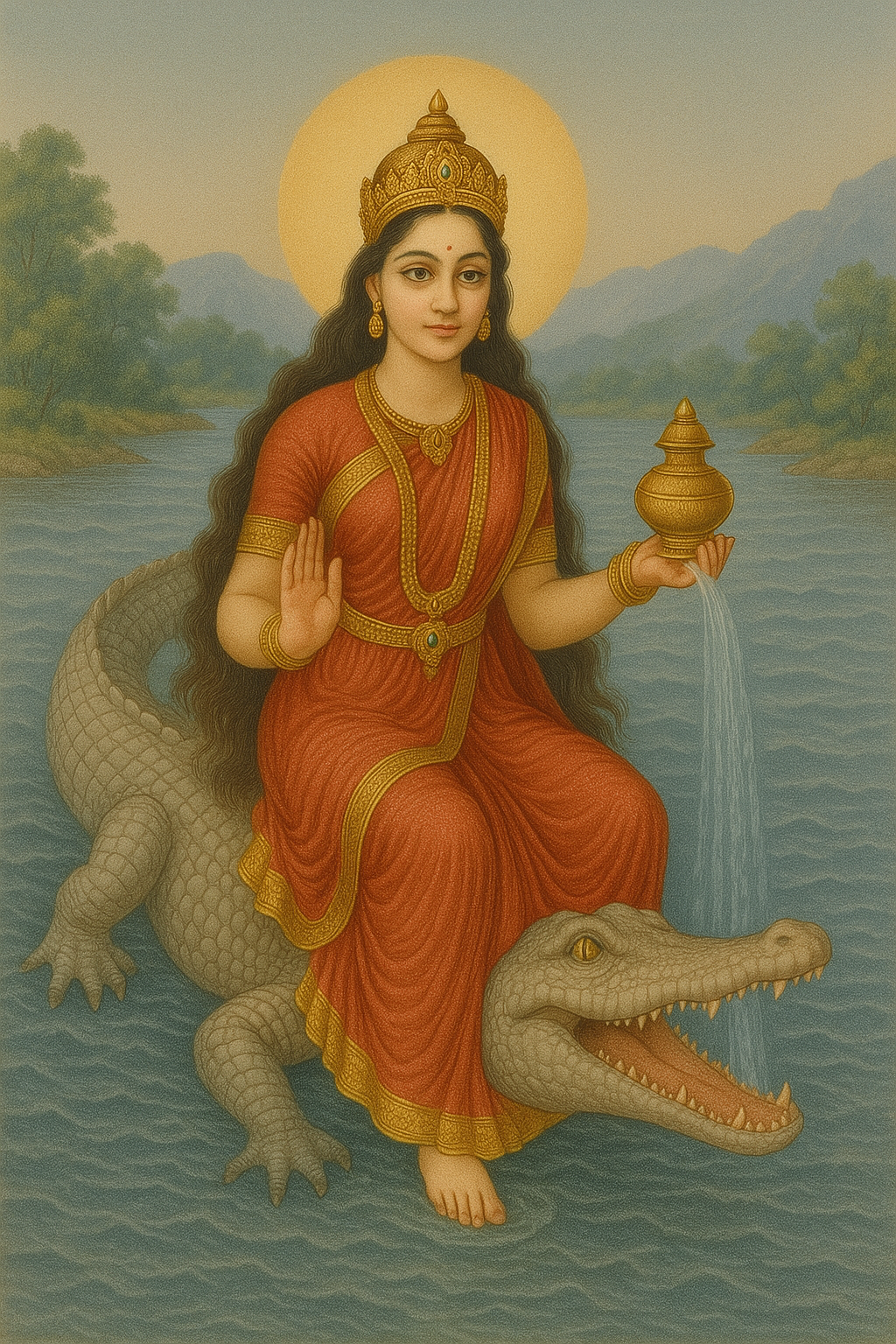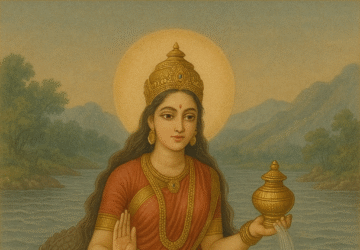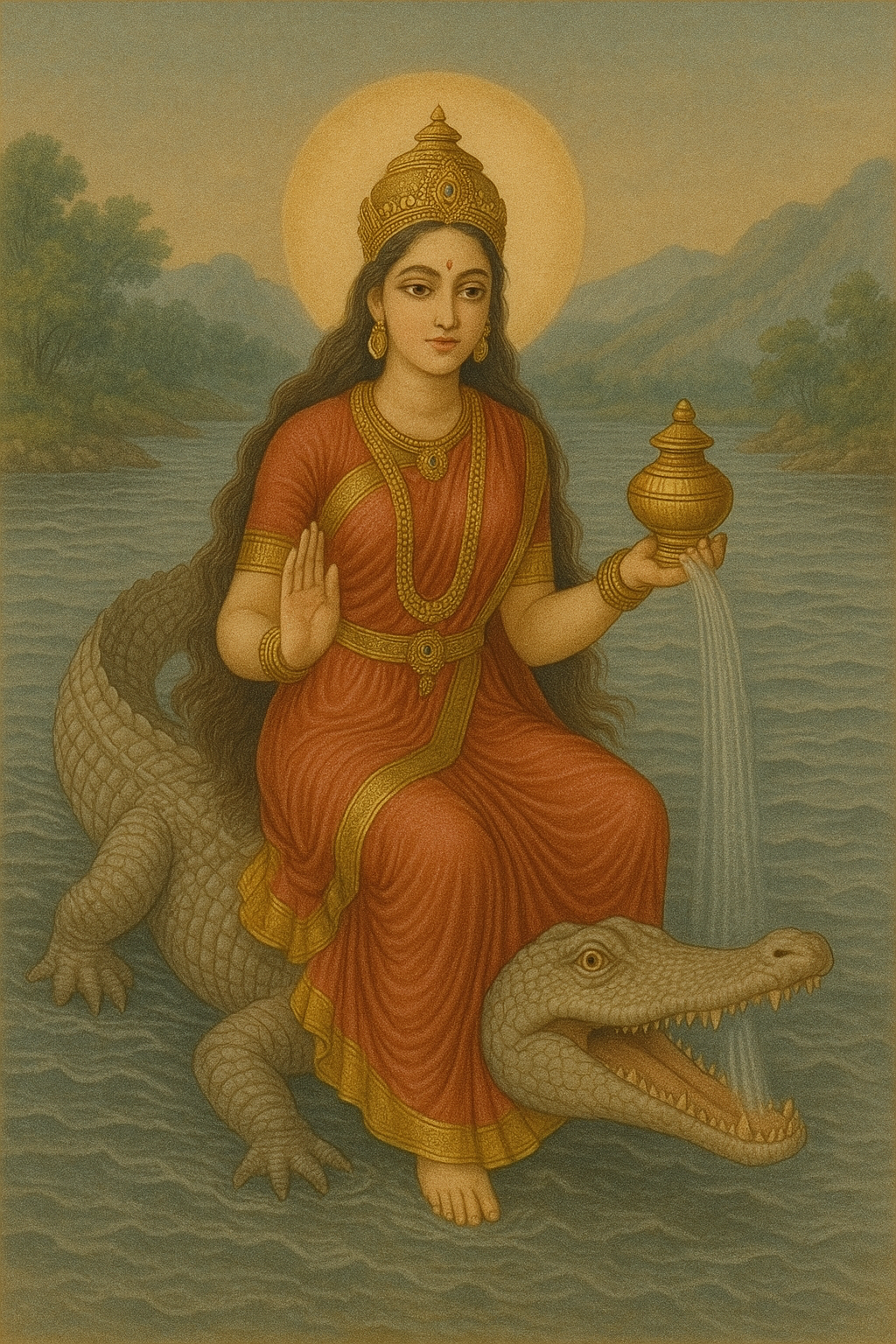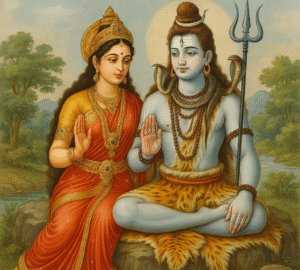हर हर गंगे जय माँ गंगे, पापनाशनी जय माँ गंगे ,मोक्षदयानी जय माँ गंगे।
गंगा मैया केवल एक नदी नहीं, बल्कि भारतीय संस्कृति, सभ्यता और आस्था का जीता-जागता प्रतीक है। इसे भारत की राष्ट्रीय नदी का दर्जा प्राप्त है और करोड़ों लोगों की जीवनदायिनी कही जाती है। भारतीय जनमानस में गंगा का स्थान माँ के समान है, जो न केवल शारीरिक प्यास बुझाती है बल्कि आत्मिक शांति और मोक्ष का मार्ग भी प्रदान करती है। गंगा का उल्लेख ऋग्वेद, रामायण, महाभारत और पुराणों में मिलता है। मान्यता है कि गंगा, भगवान विष्णु के चरणों से प्रवाहित होकर स्वर्ग से पृथ्वी पर उतरी थीं। भगीरथ की कठोर तपस्या के बाद गंगा धरती पर अवतरित हुईं और उनके पूर्वजों को मोक्ष प्रदान किया। तभी से गंगा का नाम भागीरथी भी पड़ा।
गंगा का ऐतिहासिक और पौराणिक महत्व
* उद्गम स्थल: गंगोत्री ग्लेशियर (गोमुख), उत्तराखंड
* उद्गम स्थल: गंगोत्री ग्लेशियर (गोमुख), उत्तराखंड
* लंबाई: लगभग 2525 किलोमीटर
* प्रवाह क्षेत्र: उत्तराखंड, उत्तर प्रदेश, बिहार, झारखंड और पश्चिम बंगाल
* संगम स्थल: प्रयागराज (गंगा, यमुना और सरस्वती का संगम)
* सागर मिलन: गंगा सागर, पश्चिम बंगाल
गंगा मैया केवल नदी नहीं, बल्कि एक विशाल पारिस्थितिकी तंत्र है, जो करोड़ों लोगों की आजीविका, खेती और जीवन को पोषित करती है।
धार्मिक और सांस्कृतिक महत्व
1. मोक्षदायिनी मान्यता है कि गंगा स्नान से पाप नष्ट होते हैं और आत्मा को मोक्ष प्राप्त होता है।
2. पूजा-पाठ और पर्व गंगा दशहरा, कार्तिक पूर्णिमा, मकर संक्रांति और कुंभ जैसे पर्व गंगा के तट पर ही विशेष महत्व रखते हैं।
3. अंतिम संस्कार गंगा तट पर किए गए पिंडदान और अस्थि विसर्जन आत्मा को शांति प्रदान करते हैं।
4. साहित्य और कला गंगा ने संतों, कवियों और कलाकारों की रचनाओं को प्रेरणा दी है। तुलसीदास, सूरदास और कबीर ने गंगा महिमा का गुणगान किया।
गंगा का वैज्ञानिक महत्व
* गंगा के जल में विशिष्ट बैक्टीरियोफेज पाए जाते हैं, जो हानिकारक जीवाणुओं को नष्ट करने की क्षमता रखते हैं।
* इसमें ऑक्सीजन धारण करने की अद्भुत क्षमता है, जिसके कारण इसका पानी लंबे समय तक खराब नहीं होता।
* गंगा घाटी भारत की कृषि का सबसे उपजाऊ क्षेत्र है।
आधुनिक चुनौतियाँ आज गंगा गंभीर संकटों से जूझ रही है:
1. प्रदूषण औद्योगिक कचरा, सीवेज और प्लास्टिक से गंगा का जल दूषित हो रहा है।
2. जनसंख्या दबाव करोड़ों लोग प्रतिदिन गंगा से पानी और जीवनयापन के साधन लेते हैं।
3. अवैध खनन और अतिक्रमण गंगा की प्राकृतिक धारा प्रभावित हो रही है।
4. जलवायु परिवर्तन ग्लेशियर पिघलने से गंगा के जलस्तर पर असर पड़ रहा है।
संरक्षण के प्रयास
* नमामि गंगे अभियान भारत सरकार द्वारा गंगा को पुनर्जीवित करने की सबसे बड़ी परियोजना।
* जनजागरण संतों, पर्यावरण कार्यकर्ताओं और स्थानीय लोगों का योगदान।
* पुनर्चक्रण और शुद्धिकरण संयंत्र शहरों से निकलने वाले गंदे पानी को साफ करने के प्रयास।
* हरित पहल गंगा किनारों पर वृक्षारोपण और प्लास्टिक मुक्त अभियान।
गंगा मैया की महिमा
गंगा मैया की महिमा असीम और अद्वितीय है। वे केवल एक नदी नहीं, बल्कि भारत की आत्मा और आस्था का आधार हैं। पौराणिक कथाओं के अनुसार गंगा भगवान विष्णु के चरणों से उत्पन्न होकर स्वर्ग में बहती थीं और भगीरथ की कठोर तपस्या तथा शिवजी की कृपा से पृथ्वी पर अवतरित हुईं। शिवजी ने उनके प्रचंड प्रवाह को अपनी जटाओं में समेटकर नियंत्रित किया, तभी से वे “भागीरथी” और शिव “गंगाधर” कहलाए। गंगा को मोक्षदायिनी कहा गया है क्योंकि उनके जल का स्पर्श मात्र पापों को नष्ट करता है और आत्मा को मुक्ति प्रदान करता है। हरिद्वार, वाराणसी, प्रयागराज जैसे गंगा तटों पर स्नान, पूजन और पिंडदान का विशेष महत्व है। गंगा दशहरा, कार्तिक पूर्णिमा और कुंभ जैसे पर्व गंगा के पावन जल के बिना अधूरे हैं। सांस्कृतिक दृष्टि से गंगा भारत की सभ्यता की जीवनरेखा हैं; उनके किनारे बसे नगर सदियों से ज्ञान, साधना और संस्कृति के केंद्र रहे हैं। संतों और कवियों ने गंगा की महिमा का गुणगान करते हुए उन्हें मातृरूप में पूजा है। वैज्ञानिक रूप से भी गंगा जल अद्भुत है, क्योंकि इसमें विशेष प्रकार के सूक्ष्म जीवाणुनाशक गुण पाए जाते हैं जो इसे लंबे समय तक शुद्ध और ताज़ा बनाए रखते हैं। गंगा घाटी की उपजाऊ भूमि करोड़ों किसानों की जीवनरेखा है। आज भी करोड़ों लोग गंगा को माँ मानकर उनकी आरती उतारते हैं और उनके जल को अमृत समझते हैं। वास्तव में गंगा माँ केवल पाप हरण करने वाली नदी नहीं, बल्कि जीवन देने वाली, संस्कृति को संजोने वाली और मोक्ष प्रदान करने वाली देवी हैं।

गंगा अवतरण की संपूर्ण कथा
सत्ययुग में अयोध्या के राजा सगर ने एक बार अश्वमेध यज्ञ किया। यज्ञ का घोड़ा इंद्रदेव ने छुपाकर कपिल मुनि के आश्रम के पास बाँध दिया। राजा सगर ने अपने साठ हज़ार पुत्रों को घोड़े की खोज में भेजा।जब वे घोड़े को मुनि के आश्रम में पाए, तो बिना सोचे-समझे मुनि पर चोरी का आरोप लगाने लगे। ऋषि के अपमान से क्रोधित होकर कपिल मुनि ने अपने तपोबल से उन्हें भस्म कर दिया। उनकी आत्माएँ अशांत होकर भटकने लगीं। देवताओं ने कहा – “इनकी मुक्ति तभी संभव है जब गंगा का पावन जल इनके अस्थि-अवशेषों को स्पर्श करेगा।”
भगीरथ की कठोर तपस्या
कई पीढ़ियों बाद राजा सगर के वंशज भगीरथ हुए। उन्होंने यह निश्चय किया कि अपने पूर्वजों की आत्माओं को मुक्ति दिलाएंगे। उन्होंने हिमालय की गुफाओं में जाकर कठोर तपस्या की। महीनों तक उपवास और ध्यान में लीन रहने के बाद अंततः ब्रह्मा जी उनके सामने प्रकट हुए। भगीरथ (विनम्र स्वर में):“हे जगतपिता! मेरे पूर्वज मुनि के श्राप से भस्म हो गए हैं। उनकी मुक्ति तभी संभव है जब गंगा मैया स्वर्ग से पृथ्वी पर उतरें। कृपा कर गंगा को पृथ्वी पर भेज दीजिए।” ब्रह्मा जी (गंभीर स्वर में): “वत्स, तुम्हारी इच्छा धर्ममय है। गंगा अवश्य पृथ्वी पर आएंगी। परंतु उनका प्रवाह प्रचंड है। यदि वे सीधे उतरेंगी, तो पृथ्वी चूर-चूर हो जाएगी। कोई चाहिए जो उनके उग्र वेग को संभाल सके। यह सामर्थ्य केवल महादेव शंकर में है। तुम्हें उनकी तपस्या करनी होगी।”
भगीरथ ने प्रण किया और शिवजी की आराधना में लीन हो गए। भगीरथ ने वर्षों तक कठोर साधना की। अंततः एक दिन महादेव शंकर उनके सामने प्रकट हुए। शिवजी: “वत्स भगीरथ! तुम्हारी तपस्या से मैं प्रसन्न हूँ। मैं गंगा को अपनी जटाओं में धारण करूँगा और फिर उन्हें धीरे-धीरे पृथ्वी पर छोड़ दूँगा। उसी समय स्वर्ग से गंगा का अवतरण हुआ। गंगा गर्व से बोलीं -:मैं स्वर्ग से उतर रही हूँ, मेरे प्रचंड वेग को कोई नहीं रोक सकता। मैं समस्त पाप धो डालूँगी। उनकी धारा बिजली की तरह गरजती हुई नीचे उतरी। परंतु शिवजी ने उन्हें अपनी जटाओं में समेट लिया। गंगा (क्रोधित होकर):यह कौन है जिसने मुझे रोक दिया? मैं तो संपूर्ण धरा को भेद सकती हूँ!”
शिवजी (शांत स्वर में)बोले:गंगे, शक्ति का अर्थ केवल बल नहीं, संयम भी है। यदि तुम बिना नियंत्रण के बहोगी, तो पृथ्वी नष्ट हो जाएगी। तुम्हें विनम्र होकर बहना होगा, तभी तुम्हारा अवतरण कल्याणकारी होगा। गंगा ने विनम्रता से कहा –हे महादेव! मुझे क्षमा करें। अब मैं आपकी आज्ञा का पालन करूंगी। कृपा करके मुझे पृथ्वी पर प्रवाहित कर दीजिए। शिवजी ने प्रसन्न होकर अपनी जटाओं से गंगा की एक पतली धारा पृथ्वी पर छोड़ी। गंगा मैया भगीरथ के पीछे-पीछे पृथ्वी पर बहने लगीं। वे कपिल मुनि के आश्रम तक पहुँचीं और जब उनका जल सगर पुत्रों के अस्थियों पर पड़ा, तो उनकी आत्माओं को शांति मिली और उन्हें मोक्ष प्राप्त हुआ। तभी से गंगा को भागीरथी कहा जाने लगा और शिवजी को गंगाधर कहा जाने लगा।
निष्कर्ष
गंगा मैया भारतीय संस्कृति, आस्था और जीवन का आधार हैं।गंगा मैया भारत की आत्मा और आस्था की धारा हैं। यदि गंगा स्वस्थ रहेंगी तो भारत की आत्मा भी सशक्त रहेगी। हमें गंगा को केवल धार्मिक दृष्टि से ही नहीं, बल्कि प्रकृति और जीवन की धारा के रूप में समझना होगा। हर व्यक्ति का कर्तव्य है कि गंगा को प्रदूषणमुक्त और निर्मल बनाने में योगदान दे। गंगा मैया की रक्षा करना, वास्तव में अपनी आने वाली पीढ़ियों को जीवन का उपहार देना है।आज भी गंगा स्नान, गंगा आरती और गंगा तट पर किए गए संस्कार भारतीय आस्था का सबसे पवित्र प्रतीक माने जाते हैं। जय माँ गंगे, हर हर गंगे
गंगा मैया पर FAQ
Q1. गंगा मैया का पृथ्वी पर अवतरण कब और कैसे हुआ?
👉 भगीरथ की कठोर तपस्या से प्रसन्न होकर ब्रह्मा जी ने गंगा को पृथ्वी पर भेजा। उनके प्रचंड प्रवाह को नियंत्रित करने के लिए शिवजी ने उन्हें अपनी जटाओं में धारण किया और धीरे-धीरे धरती पर छोड़ा।
Q2. गंगा को ‘मोक्षदायिनी’ क्यों कहा जाता है?
👉 गंगा जल का स्पर्श पापों को नष्ट करता है और आत्मा को मुक्ति प्रदान करता है। गंगा स्नान, पिंडदान और अस्थि विसर्जन से पूर्वजों की आत्मा को मोक्ष मिलता है।
Q3. गंगा मैया को किन-किन नामों से जाना जाता है?
👉 गंगा को भागीरथी, जाह्नवी, त्रिपथगा, विष्णुपदी और मंदाकिनी जैसे अनेक नामों से जाना जाता है।
Q4. गंगा जल की विशेषता क्या है?
👉 गंगा जल लंबे समय तक खराब नहीं होता, क्योंकि इसमें रोगाणुनाशक तत्व और विशेष ऑक्सीजन धारण करने की क्षमता होती है।
Q5. गंगा से जुड़े प्रमुख धार्मिक स्थल कौन-कौन से हैं?
👉 हरिद्वार, ऋषिकेश, वाराणसी, प्रयागराज, गंगासागर, देवप्रयाग और गंगोत्री गंगा से जुड़े प्रमुख तीर्थ स्थल हैं।
Q6. गंगा दशहरा पर्व का क्या महत्व है?
👉 गंगा दशहरा वह दिन है जब गंगा माँ का अवतरण हुआ था। इस दिन गंगा स्नान और दान करने से सभी पापों का नाश होता है।
Q7. गंगा संरक्षण क्यों आवश्यक है?
👉 गंगा करोड़ों लोगों की जीवनरेखा हैं। प्रदूषण और कचरे से गंगा का अस्तित्व खतरे में है, इसलिए उनका संरक्षण केवल धार्मिक ही नहीं बल्कि पर्यावरणीय और सामाजिक जिम्मेदारी भी है।






